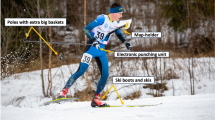Abstract
Due to the low recognition accuracy and slow convergence speed of the traditional basketball shooting trajectory recognition methods, this paper proposes a basketball shooting trajectory recognition method based on transfer learning to accurately analyze the behavior pattern of shooting trajectory in the monitoring scene. The improved Hough method is used to obtain the basketball position, combined with the basketball speed, the cerebellar model neural network is constructed, the recursive unit is added with the recursive neural network, and then the variable weight is designed to improve the network structure. Combined with transfer learning, the speed of improving network optimization is accelerated, the missing information is made up, and the recognition of basketball shooting trajectory is realized. Experiments show that this method can accurately identify the basketball shooting trajectory with the minimum coordinate error, effectively improve the accuracy and time of network training, and improve the convergence speed and recognition accuracy.











Similar content being viewed by others
References
Liu N, Liu P (2021) Goaling recognition based on intelligent analysis of real-time basketball image of Internet of Things. J Supercomput 15(2):1–21
Xiao Y (2018) Research on Simulation of Motion Track Recognition for Multimedia Visual Images . Comp Simul 35(10), 252–255+275
Cao W, Li Z X, Wei Q, Chu YJ (2018) Trajectory classification method based on probability density estimation of regional distribution. Comp Eng 44(04), 262–267+286.
Garzón G, Martínez F (2019) A fast action recognition strategy based on motion trajectory occurrences. Pattern Recognit Image Anal 29(3):447–456
Kumar N, Sukavanam N (2018) Motion trajectory for human action recognition using fourier temporal features of skeleton joints. J Image Graph 6(2):174–180
Liu S, Liu X, Wang S et al (2021) Fuzzy-Aided Solution for Out-of-View Challenge in Visual Tracking under IoT Assisted Complex Environment. Neural Comput Appl 33(4):1055–1065
Wang M, Lin Y, Tian Q et al (2021) Transfer Learning Promotes 6G Wireless Communications: Recent Advances and Future Challenges. IEEE Trans Reliab 70(2):790–807
Karbalayghareh A, Qian X, Dougherty ER (2018) Optimal bayesian transfer learning. IEEE Trans Signal Process 66(14):3724–3739
Shuai L, Dongye L, Gautam S et al (2021) Overview and methods of correlation filter algorithms in object tracking. Comp Intel System 7:1895–1917
Li T, Du L, Sun J, Zhang YJ, Zou FY (2019) Typical cross section silhouette analysis and interval prediction model construction of shorts. J Text Res 40(05):113–118
Xi Y, Li Z, Tang X, Zeng X (2020) Classification of power quality disturbances based on kf-ml-aided s-transform and multilayers feedforward neural networks. IET Gener Transm Distrib 14(19):4010–4020
Cao JX, Qin Z, Zeng Z et al (2020) A Convolutional Neural Network for Ghost Image Recognition and Waveform Design of Electrophoretic Displays. IEEE Transac Consume Electron 224(8):107090
Shuai L, Shuai W, Xinyu L et al (2021) Human Memory Update Strategy: A Multi-Layer Template Update Mechanism for Remote Visual Monitoring. IEEE Transac Multimed 23:2188–2198
Long J, Peng Y, Li J et al (2021) Hyperspectral Image Super-resolution via Subspace-based Fast Low Tensor Multi-Rank Regularization. Infrared Phys Technol 15(02):357–364
Kong Z, Zhang Y, Wang X, Xu Y, Jin B (2020) Prediction and optimization of a desulphurization system using cmac neural network and genetic algorithm. J Environ Eng Landsc Manag 28(2):74–87
Han D, Liu Q, Fan W (2018) A new image classification method using cnn transfer learning and web data augmentation. Expert Syst Appl 95(4):43–56
Kratzwald B, Feuerriegel S (2018) Putting question-answering systems into practice: transfer learning for efficient domain customization. ACM Trans Manag Inf Syst 9(4):37–56
Liu S, Wang S, Liu X et al (2021) Fuzzy Detection aided Real-time and Robust Visual Tracking under Complex Environments. IEEE Trans Fuzzy Syst 29(1):90–102
Alothman B (2018) Similarity-based instance transfer learning for botnet detection. Int J Intel Comput Res 9(1):880
Kolar Z, Chen H, Luo X (2018) Transfer learning and deep convolutional neural networks for safety guardrail detection in 2d images. Autom Constr 89(5):58–70
Acknowledgements
The paper is funded by Project of Science and Technology Plan of Inner Mongolia Autonomous Region with No.2020GG0169.
Author information
Authors and Affiliations
Corresponding author
Ethics declarations
Ethics Approval
The authors have no relevant financial or non-financial interests to disclose. Fanlong Meng provided the algorithm and experimental results, wrote the manuscript, Ting Yang revised the paper, supervised and analyzed the experiment. We also declare that data availability and ethics approval is not applicable in this paper.
Additional information
Publisher's Note
Springer Nature remains neutral with regard to jurisdictional claims in published maps and institutional affiliations.
Rights and permissions
About this article
Cite this article
Meng, Fl., Yang, T. A Recognition Method of Basketball’s Shooting Trajectory Based On Transfer Learning. Mobile Netw Appl 27, 1271–1282 (2022). https://doi.org/10.1007/s11036-022-01949-z
Accepted:
Published:
Issue Date:
DOI: https://doi.org/10.1007/s11036-022-01949-z




